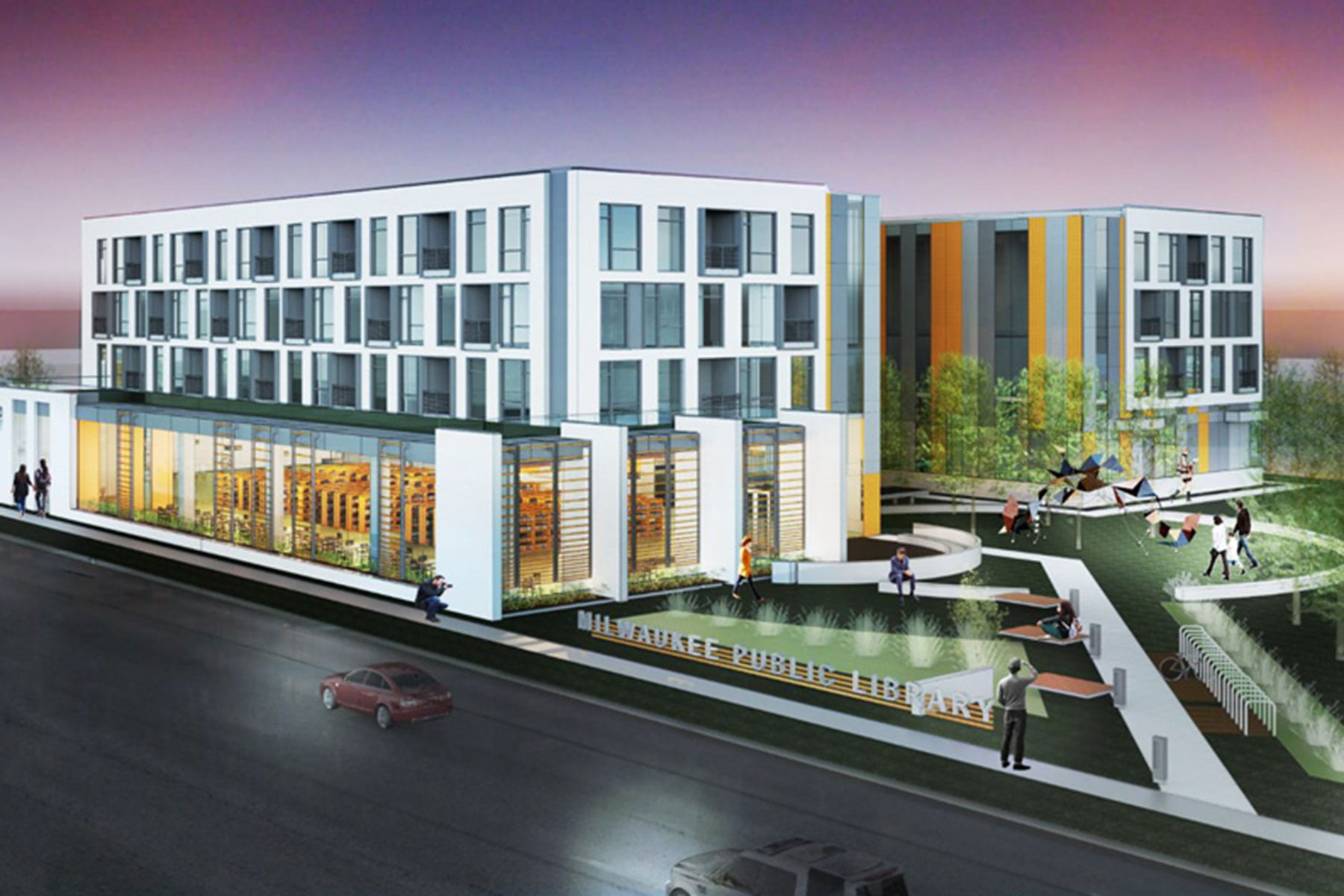Borrowing Beyond the Books: A Reactionary Review of Mixed-use Libraries in Milwaukee
Maddi Brenner, Library & Information Science and Urban Studies Master Student, University of Wisconsin Milwaukee

Mill Road Library Rendering // Photo citation:http://www.milwaukeeindependent.com/curated/new-mill-road-library-moves-ahead-after-tax-credit-award
At the start of the 21st century, Milwaukee Mayor Tom Barrett initiated a mass redevelopment project benefiting the branch libraries of the Milwaukee Public Library System. In his proposal, an estimated $22.5 million dollar budget would resolve to finance the redevelopment of at least five of the branch libraries in the city, “We are going to invest in libraries because we think they are great additions to neighborhoods, to learning, to safety, to community, just everything up and down the line,” stated Barrett (Milwaukee Public Library System, 2020). Today, the city has implemented the redevelopment of four new facilities: Villard Square Branch, East Branch and Forest Home (now Mitchell Street) with additional libraries following suit (MPL, 2020). These libraries, known as mixed-use libraries are traditional in perspective with the main difference being their inclusion of housing and apartments using redeveloped property and investment from housing developers.
Mixed-use development at the library introduces significant levels of public-private partnership between developer, city governance and the library through an urban revitalization framework and perhaps, a neoliberal agenda in the city. How do mixed-use libraries perform? Are they merely a by-product of urban renewal and Richard Florida’s creative class development strategies? What can be expected in the future for mixed-use libraries? These questions seek research exploration on the rise of mixed-use libraries and their manifestation into recurring themes of neoliberalism and new urbanism in planning and redevelopment, most notably in Milwaukee and several other cities across the United States.
The integration of mixed-use development model into the redevelopment phase for branch libraries is rising across cities in the United States (Unrau, 2016; Murvosh, 2012; Dubb, 2018; McCormick, 2019). Its expansion has been “an integral part of the urban landscape” and marks a turning point for city libraries (DeLisle & Grissom, 2013). Defined by the MRSC of Washington (2019), “mixed-use development is pedestrian-friendly development that blends two or more residential, commercial, cultural, institutional, and/or industrial uses” and “a planning strategy that seeks community design and development that serves the economy, community, public health, and the environment.” The model can exist in many forms, such as cafes, shopping centers, parking garages, etc., for both public spaces and libraries (Esajian, 2020). Notably, the mixed-use development model assumes a “multi-functional opportunity” for business, city and the library (Murvosh, 2012). To libraries in need of redevelopment (with significantly limited funding), the mixed-use development model manifests itself into a contemporary and revolutionary idea that contributes to the expansion of library services and a growing of neighborhoods and communities.
In Milwaukee, plans are already in place for the Martin Luther King branch (MLK) and the Good Hope with an issuing of proposal requests, partnership decisions and a “public input sessions.” At first glance, the concept of mixed-use development is an enticing fix to revitalization in the city while facilitating cost reduction and dismantling some sense of the housing crisis (Holland, 2014; Ramlee, M., Omar, D., Yunus, R. M., & Samadi, Z., 2015). Yet, recognizing which branch library is chosen, at what time and how, in what neighborhood and why, with the addition of city officials and developers decision and partnership for redevelopment of the space must be analyzed. Notoriously labeled as one of the lasting portrayals of democracy, the library can reflect instances of equality and access for all… Until it doesn’t. At what cost? And for whom? What is the future of our public libraries? Further research is needed in order to understand and acknowledge this growing trend in cities across the United States and in Milwaukee.
Reference
ALA (American Library Association). (2020, April 28). Library Funding. Retrieved April 29, 2020, from http://www.ala.org/advocacy/library-funding
Milwaukee Public Library – City of Milwaukee · MPL. (2020). Retrieved April 29, 2020, from http://www.mpl.org/
Dubb, S. (2018, June 11). Libraries as Affordable Housing Partners? Retrieved April 29, 2020, from https://nonprofitquarterly.org/libraries-as-affordable-housing-partners/
Unrau, R. (2016, October 25). New Mixed-Use Development Plan to Combine Libraries With Housing. Retrieved April 29, 2020, from https://news.wttw.com/2016/10/25/new-mixed-use-development-plan-combine-libraries-housing
Murvosh, M. (2012). Better. Library Journal, 137(9), 20–24.
Murvosh, M. (2012, May 15). Powerful Partnerships: Introduction and Best Practices: Library by Design, Spring 2012. Retrieved November 2, 2019, from https://www.libraryjournal.com/detailStory=powerful-partnerships-intro-library-by-design-spring-2012.
DeLisle, J., & Grissom, T. (2013). An Empirical Study of the Efficacy of Mixed-Use Development: The Seattle Experience. Journal of Real Estate Literature, 21(1), 25–57.
McCormick, K. (2019, September 27). A New Chapter: Cities Are Tackling the Housing Crunch —by Building Above the Library. Retrieved April 29, 2020, from https://www.lincolninst.edu/es/publications/articles/new-chapter
MRSC of Washington. (2019, July 31). Ask MRSC. Retrieved November 3, 2019, from http://mrsc.org/Home/Explore-Topics/Planning/Development-Types-and-Land-Uses/Mixed-Use.aspx.
Esajian, J. D. (2020, April 27). Mixed Use Development 101: 10 Impressive Examples. Retrieved April 29, 2020, from https://www.fortunebuilders.com/mixed-use-developments-on-the-rise/
Holland, S (2014). Weaving policy, people & place together, revitalizing broadway east what does “revitalizing” mean?, Retrieved April 15, 2020 from http://www.mpnh.org/~Assets/Document/Wpppt/Revitalization–%20Working%Definition1.pdf
Ramlee, M., Omar, D., Yunus, R. M., & Samadi, Z. (2015). Revitalization of Urban Public Spaces: An Overview. Procedia – Social and Behavioral Sciences, 201, 360–367. doi: 10.1016/j.sbspro.2015.08.187
